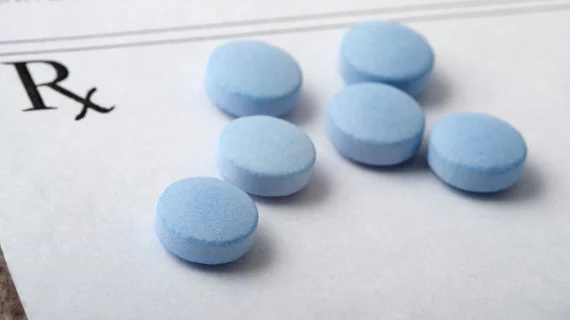Patient adherence dropped after more expensive P2Y12 inhibitors became available
Once more expensive P2Y12 inhibitors hit the U.S. market, the percentage of patients not filling prescriptions for any P2Y12 inhibitor after percutaneous coronary intervention (PCI) increased from 6 percent to 19 percent, researchers reported in JAMA Internal Medicine.
Considering the long-term adherence was lower for these new agents (prasugrel and ticagrelor) compared to the more established option (clopidogrel), lead author Elias J. Dayoub, MD, MPP, and colleagues concluded increasing copayments contributed to lower adherence. The authors also noted residents of poorer areas had worse adherence, further strengthening the cost-based argument.
“An important policy ramification of our findings is that the introduction of new pharmacotherapies may have exacerbated socioeconomic health disparities,” wrote Dayoub, with the University of Pennsylvania, and coauthors. “Increased prescribing of newer, more expensive agents may be … affecting health outcomes disparities by worsening adherence among patients with low socioeconomic status and placing them at increased risk for downstream adverse cardiovascular events.”
Dayoub et al. studied 55,340 patients who received PCI from 2008 through 2016. They used an insurance database which contained information on inpatient, outpatient and pharmacy claims to measure whether patients were initially adherent to medication and how well they continued therapy over periods of six and 12 months.
P2Y12 inhibitors are cornerstones of post-PCI care, with an analysis of the National Cardiovascular Data Registry showing physicians prescribed one of the drugs 99 percent of the time after a stenting procedure. For this reason, Dayoub and colleagues pointed out most of the nonadherence observed in the study could be attributed to patients not filling their prescriptions rather than low physician prescribing rates.
Trials demonstrating the relative benefits of the newer P2Y12 inhibitors have led to class IIA recommendations that they be used instead of clopidogrel for certain patient populations. Prasugrel was approved by the FDA in July 2009, while ticagrelor received FDA approval in July 2011.
In 2008, before those drugs were available, the researchers found 93.6 percent of patients filled prescriptions for clopidogrel within 30 days of PCI. But in 2016, the proportion of patients filling a prescription for any P2Y12 inhibitor dropped to 81 percent—44 percent clopidogrel and 36.9 percent for either of the newer drugs.
And patients taking clopidogrel were most likely to be adherent over the long term, having access to the medication 85 percent of time over a six-month period and 76 percent of the time over a 12-year period based on prescription filling habits. The proportion of days covered by prasugrel and ticagrelor prescriptions over a one-year period was 71 and 68 percent, respectively.
Finally, the authors calculated the average copayment of clopidogrel was $251 for one year compared to more than $550 for the other drugs.
“While it was impossible to know the specific P2Y12 inhibitor that primary nonadherent patients failed to fill, the rising proportion of patients who were given prescriptions for prasugrel and ticagrelor during the study period as well as the sizeable difference in mean copayments between clopidogrel and the newer agents suggest that increased prescribing of the newer, more expensive P2Y12 inhibitors may be contributing to increasing primary nonadherence,” the researchers wrote.
Dayoub and colleagues acknowledged their method of measuring nonadherence was inexact because a patient may have acquired the medications outside of the insurance plan, although they only analyzed patients who filled at least one prescription of any type through insurance. Also, their study excluded patients older than 64, so the results may not apply to older populations.
In an invited commentary, two researchers from Harvard Medical School and Brigham and Women’s Hospital said patients have commonly been seen as careless, stubborn or naïve about the benefits of medication. But to attribute nonadherence solely to these factors would be a mistake, they said.
Everything from high out-of-pocket costs, a pharmacy’s hours and distance from the patient and insurance restrictions may contribute to a lack of compliance. Physicians may also be guilty of poor explanations of complex treatment regimens or inadequately describe their therapeutic benefit.
“A shift from individual actors to systems thinking for medication adherence is analogous to the transition that occurred decades ago for errors in medicine,” wrote Julie C. Lauffenberger, PharmD, PhD, and Niteesh K. Choudhry, MD, PhD. “We have come to understand that most errors do not result from the negligent acts of individuals but rather a result of failures at multiple points along a care pathway. In the world of medical errors, we learned to stop blaming individual health care professionals; in the world of nonadherence, we should stop blaming patients.”
The editorialists added one way to curb cost-related nonadherence would be to present all available coverage options to patients and engage in shared decision-making based on what patients can afford.
“In this context, this could mean prescribing clopidogrel rather than prasugrel or ticagrelor, even if its efficacy may be lower,” they wrote. “After all, higher long-term adherence to a slightly less-effective therapy might ultimately be more beneficial than short-term adherence to the best available therapy.”

